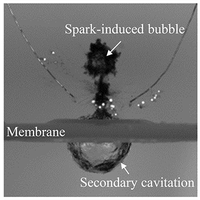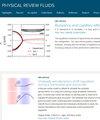在火花引发的气泡喷射作用下,弹性膜变形所产生的气蚀现象
IF 2.5
3区 物理与天体物理
Q2 PHYSICS, FLUIDS & PLASMAS
引用次数: 0
摘要
火花引发的气泡坍塌会产生高速射流,当射流撞击弹性膜时,后者会发生显著变形,并伴随二次空化。空化气泡随后会随着振荡远离薄膜。为了研究这种空化的机理,我们进行了漫射光和粒子图像测速仪实验,以捕捉空化泡的行为和膜快速变形产生的流场。对速度场和压力场的分析表明,二次空化是由突然加速而不是大速度引起的。当无量纲惯性力超过空化所需的无量纲压力差时,就会发生二次空化;对这些无量纲量进行参数化研究表明,当前者大于后者时,就会发生二次空化。在空化气泡坍塌过程中,细射流以大约 35 米/秒的冲击速度指向薄膜。空化泡随后的振荡导致涡流远离膜。这些发现为生物工程和混合等工程应用提供了启示。本文章由计算机程序翻译,如有差异,请以英文原文为准。

Cavitation caused by an elastic membrane deforming under the jetting of a spark-induced bubble
The collapse of a spark-induced bubble results in a high-speed jet, and when that jet impacts an elastic membrane, the latter deforms considerably and is accompanied by secondary cavitation. The cavitation bubble then moves away from the membrane with subsequent oscillation. To study the mechanism for this cavitation, experiments involving diffuse light and particle image velocimetry were conducted to capture the behaviors of the cavitation bubble and flow field resulting from the rapid deformation of the membrane. Analyzing the velocity and pressure fields reveals secondary cavitation induced by a sudden acceleration rather than a large velocity. Secondary cavitation occurs when the dimensionless inertial force overcomes the dimensionless pressure difference required for cavitation; subjecting these dimensionless quantities to a parametric study shows that the secondary cavitation occurs when the former is greater than the latter. During the collapse of the cavitation bubble, a thin jet points toward the membrane with an impact velocity of approximately 35 m/s. The subsequent oscillation of the cavitation bubble results in vortex flow moving away from the membrane. These findings provide insights into engineering applications such as bioengineering and mixing.
求助全文
通过发布文献求助,成功后即可免费获取论文全文。
去求助
来源期刊

Physical Review Fluids
Chemical Engineering-Fluid Flow and Transfer Processes
CiteScore
5.10
自引率
11.10%
发文量
488
期刊介绍:
Physical Review Fluids is APS’s newest online-only journal dedicated to publishing innovative research that will significantly advance the fundamental understanding of fluid dynamics. Physical Review Fluids expands the scope of the APS journals to include additional areas of fluid dynamics research, complements the existing Physical Review collection, and maintains the same quality and reputation that authors and subscribers expect from APS. The journal is published with the endorsement of the APS Division of Fluid Dynamics.
 求助内容:
求助内容: 应助结果提醒方式:
应助结果提醒方式:


